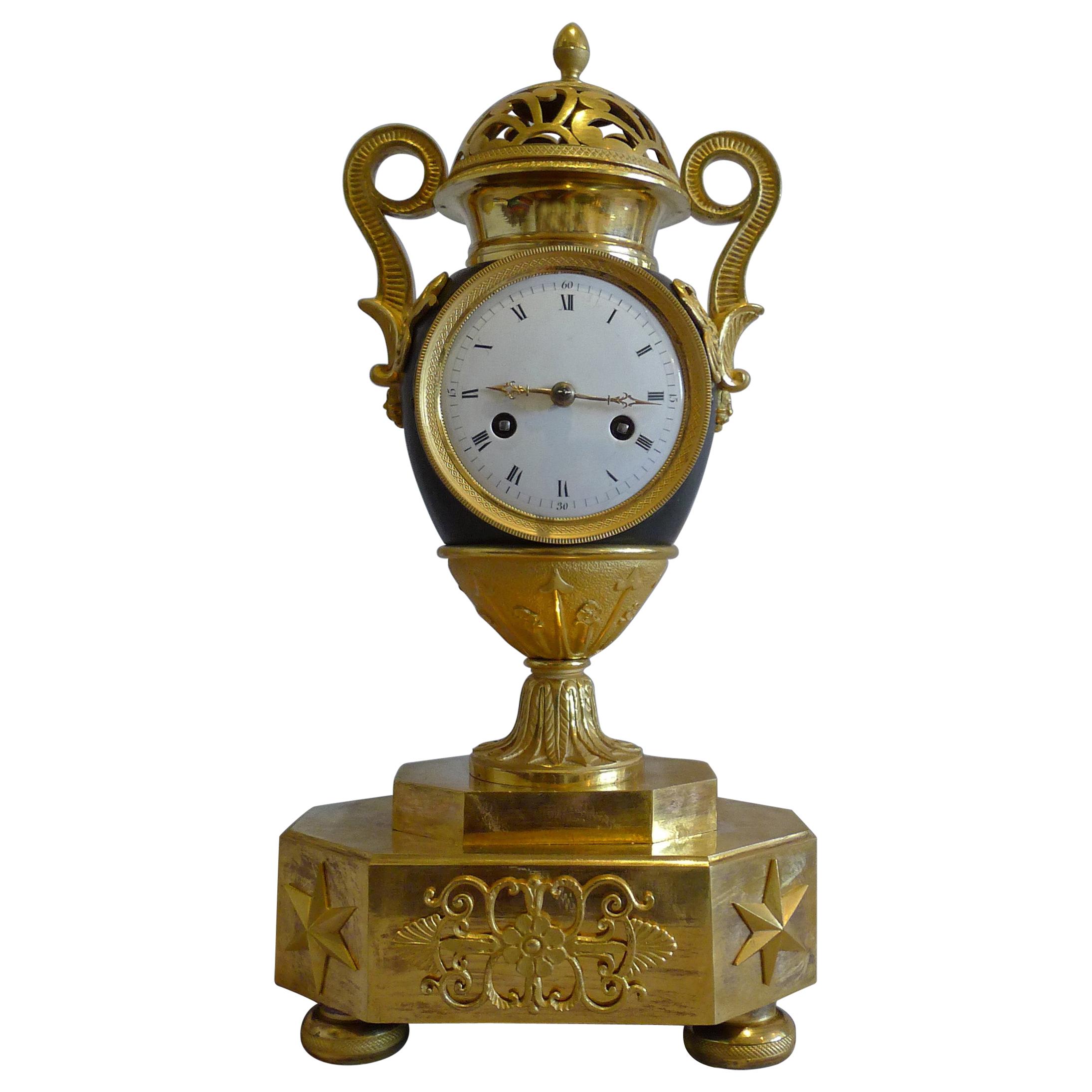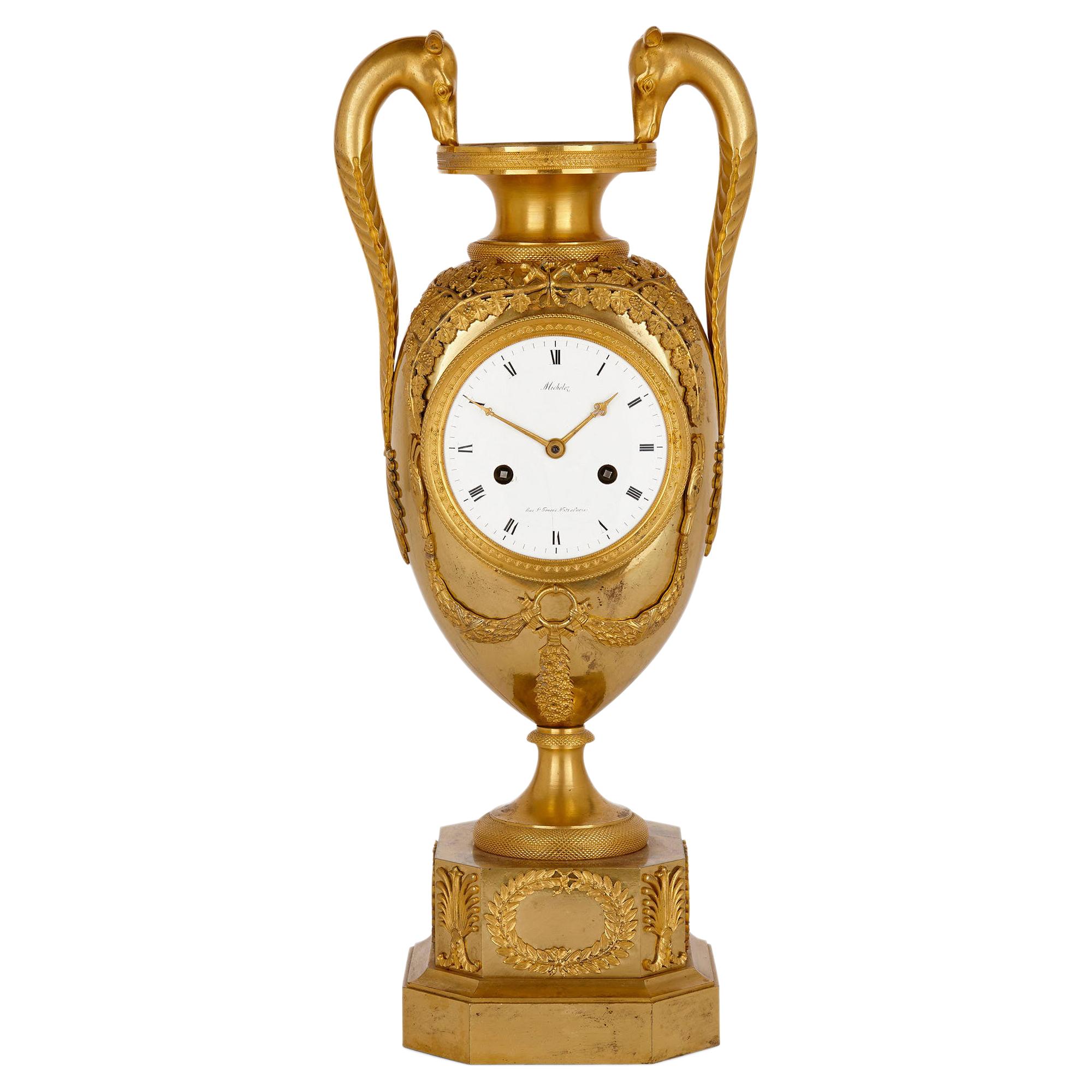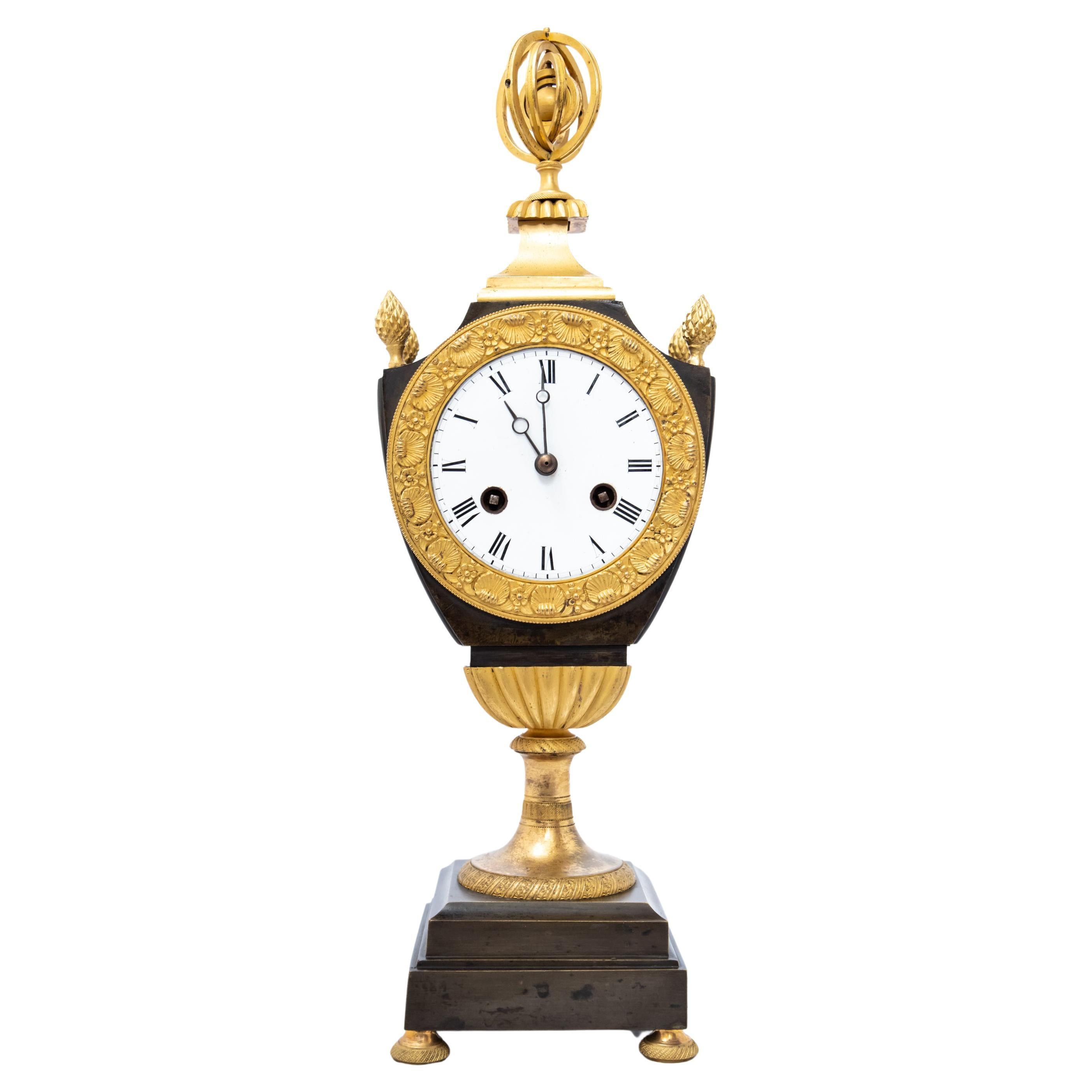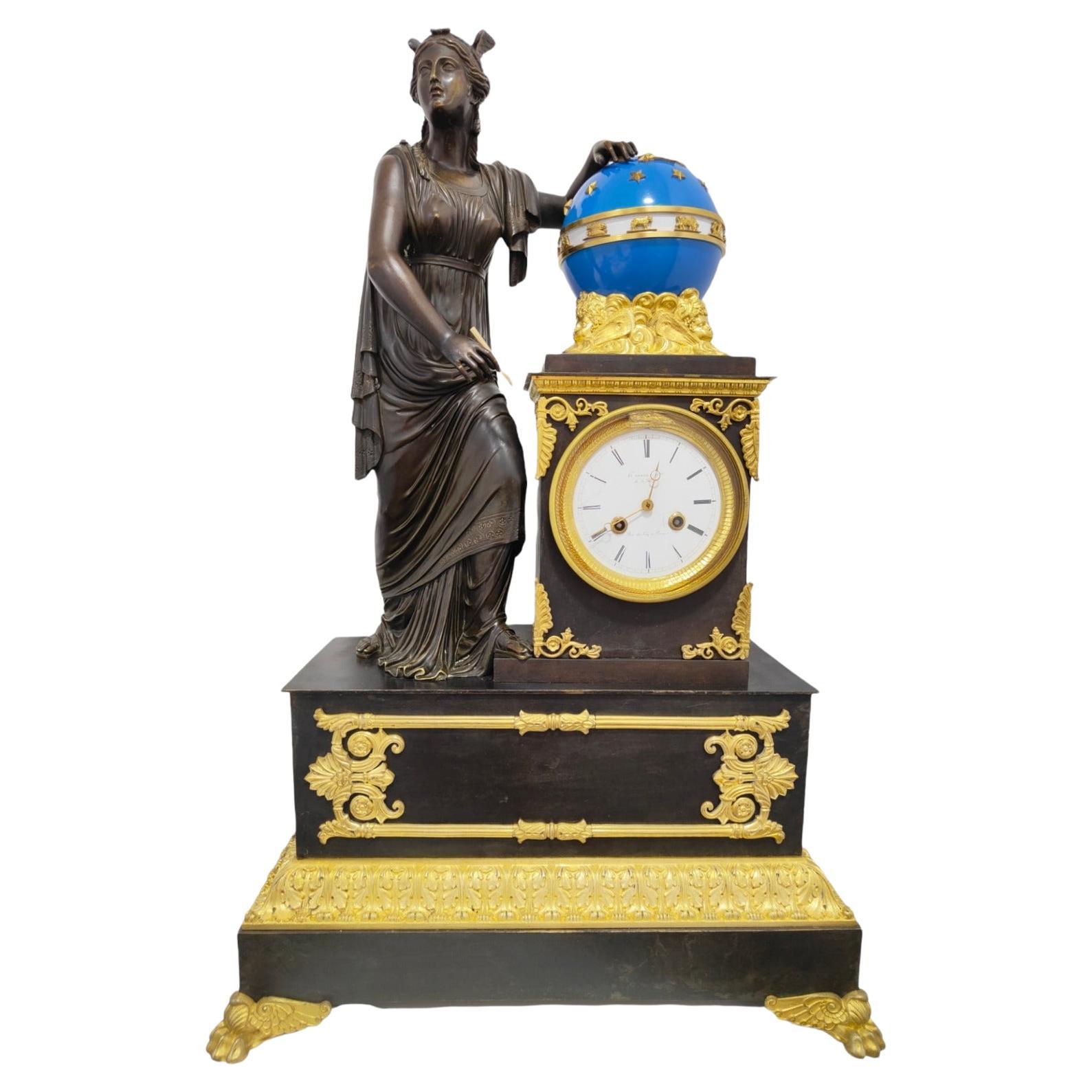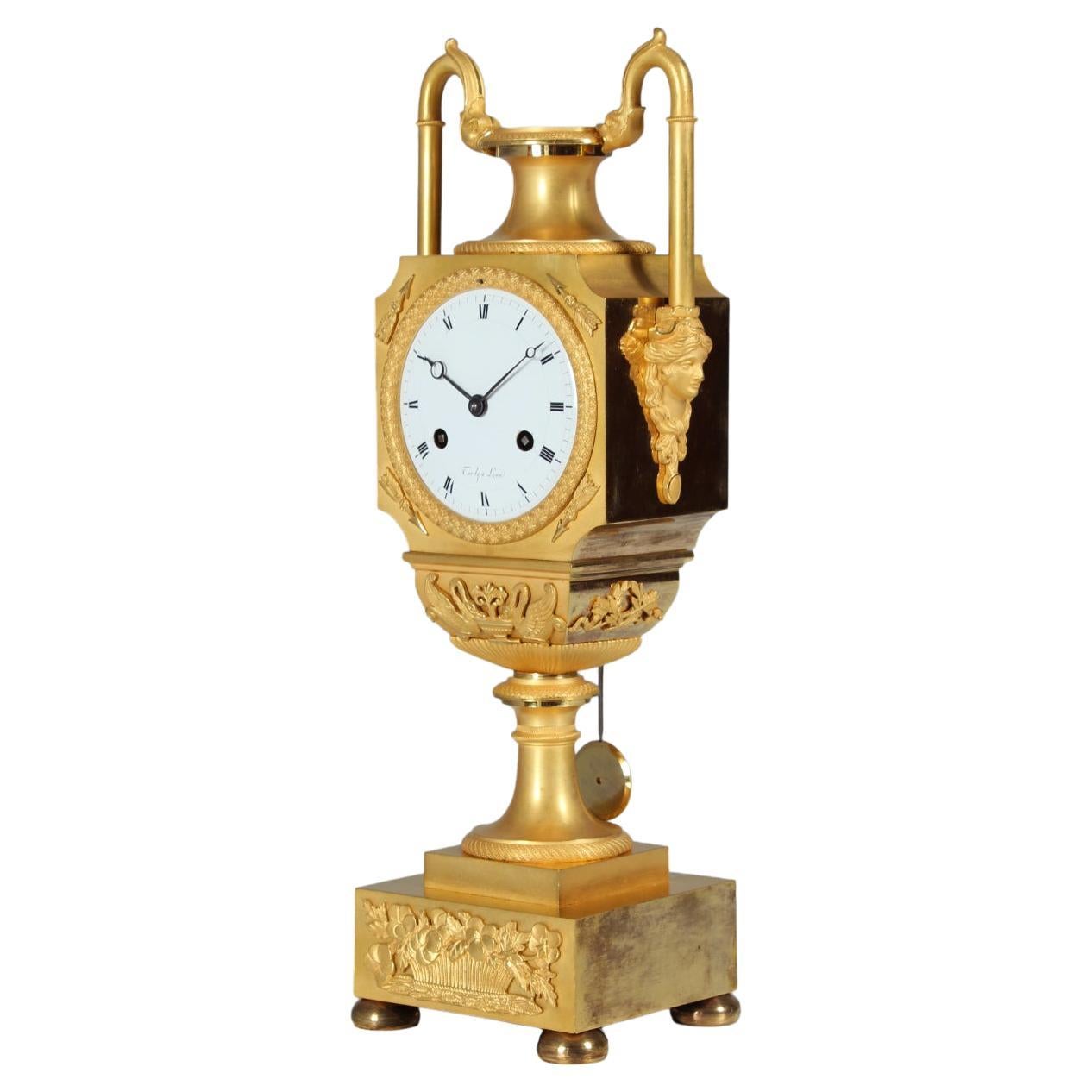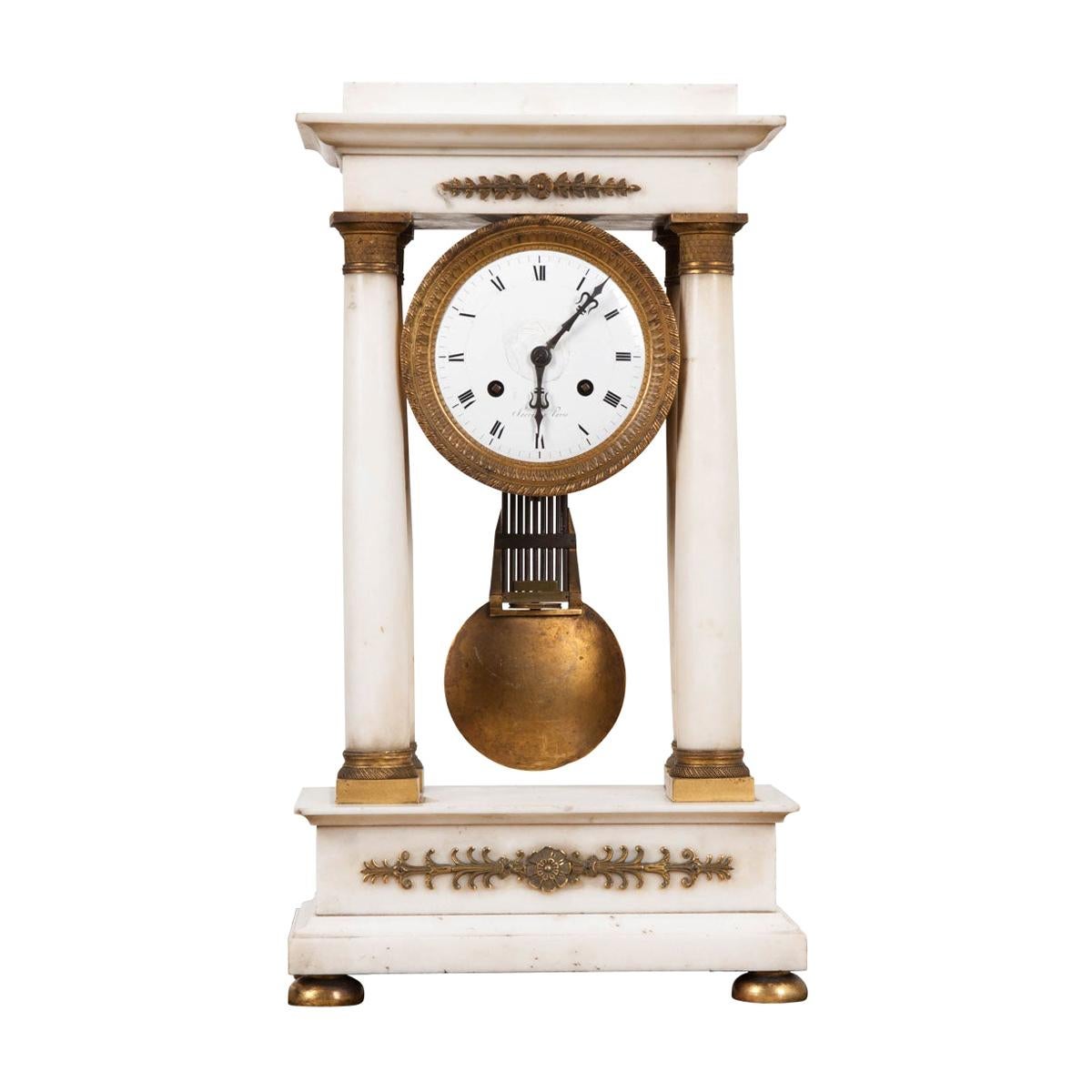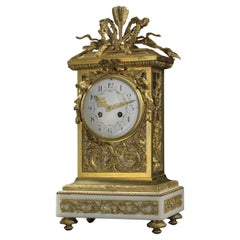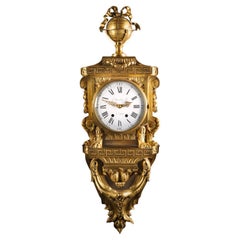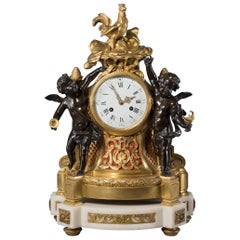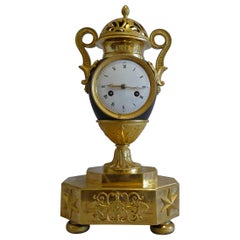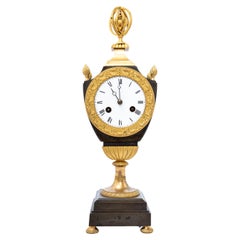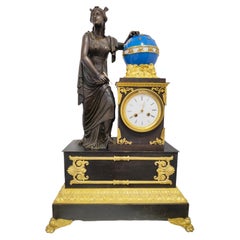Items Similar to Empire Clock in the Form of a Classical Urn, by Maison Lepautre, circa 1825
Want more images or videos?
Request additional images or videos from the seller
1 of 8
Empire Clock in the Form of a Classical Urn, by Maison Lepautre, circa 1825
$5,636.89
£4,200
€4,849.14
CA$7,909.40
A$8,630.92
CHF 4,479.96
MX$103,261.56
NOK 56,864.91
SEK 53,264.63
DKK 36,221.51
About the Item
A gilt bronze Empire clock in the form of a classical urn, by Maison Lepautre.
French, circa 1825.
The dial signed 'Lepaute a Paris'.
The clock has an ornate cast bezel with a 3-inch porcelain dial with Roman numerals and Breguet style hands. The twin train eight-day movement with outside count wheel striking on a bell and silk thread suspension.
This elegant Empire style clock has a gilt bronze case in the form of a classical urn with swan neck handles and a winged cherub to the neck. The circular pedestal base is raised on a footed stepped square plinth.
The Lepaute family were the premier French clockmakers of their day. Their significance lies in their contribution to the clock making industry which had hitherto come under the trade of locksmiths. The family held the brevet Horlogers du Roi.
Jean-André Lepaute (1720–1789) arrived in Paris at an early age and in 1740 founded the family business. A skilled artist and mechanic, he quickly gained an excellent reputation. He was received as maître by the clockmakers guild in 1759, was granted royal lodgings from the king in The Luxembourg Palace, and was entrusted with the construction of the majority of the great public clocks of Paris. He executed, amongst others, those in The Luxembourg Palace, the Jardin des Plantes, the Château de Bellevue and the Château des Ternes. His clock at Paris’s École Militaire still works today. Three editions of his Traité d’Horlogerie were published in Paris in 1755, 1760 and 1767. A small volume, Description de Plusieurs Ouvrages d’Horlogerie appeared in 1764. Jean-André’s wife, Nicole-Reine Etable de la Brière (1723-1788), was a highly esteemed mathematician and astronomer. Her passion for science lent itself to Lepaute’s work and she played an active role in the scientific and mathematical aspects of the clock making.
Jean-André’s younger brother Jean-Baptiste Lepaute (1727-1802) joined him in Paris in 1747 and immediately started working for the family business. He was received as maître in 1776 and was known for the clocks he constructed for the Paris Hôtel de Ville (1780), destroyed in a fire of 1871, and for the Hôtel des Invalides (1784). Jean-Baptiste took over the workshop when Jean-André retired in 1775.
After Jean-Baptiste’s death in 1802, the firm was taken over by his nephew Pierre-Basil Lepaute (1750-1843) where he was duly joined by his own nephew Jean-Joseph (1768-1846) and son Pierre-Michel (1785-1849). By 1816, Pierre-Michel Lepaute was in charge of the business. His masterpieces include the astronomical clock in Paris’s Bureau des Longitudes and those in the city’s Bourse (stock exchange), the Hôtel des Postes, the Louvre Palace, the Tuileries Palace and the Château de Compiègne. Pierre-Michel invented the horological principle of ‘remontoir d’égalité’, a force mechanism which is still used by clockmakers today. From 1862 until 1867 the company was run by Pierre-Michel’s two sons Léon Henry-Lepaute and Paul Henry-Lepaute.
- Creator:Pierre-Basile Lepaute (Clockmaker)
- Dimensions:Height: 13 in (33 cm)Width: 6.7 in (17 cm)Depth: 3.94 in (10 cm)
- Style:Empire (Of the Period)
- Materials and Techniques:
- Place of Origin:
- Period:
- Date of Manufacture:circa 1825
- Condition:
- Seller Location:Brighton, GB
- Reference Number:Seller: B734101stDibs: LU1028014469901
About the Seller
5.0
Recognized Seller
These prestigious sellers are industry leaders and represent the highest echelon for item quality and design.
Established in 1964
1stDibs seller since 2014
59 sales on 1stDibs
Typical response time: 1 hour
Associations
The British Antique Dealers' AssociationLAPADA - The Association of Arts & Antiques Dealers
- ShippingRetrieving quote...Shipping from: Brighton, United Kingdom
- Return Policy
More From This Seller
View AllA Louis XVI Style Mantel Fine Gilt-Bronze Clock by François Linke
By François Linke
Located in Brighton, West Sussex
A Very Fine Gilt-Bronze Clock With A White Marble Base by François Linke.
The case signed 'Linke'.
This rare example of a clock by François Linke has a twin train eight-day mov...
Category
Antique 19th Century French Louis XVI Mantel Clocks
Materials
Marble, Enamel, Ormolu
Louis XVI Style Gilt Bronze and White Marble Clock By François Linke, circa 1890
By François Linke
Located in Brighton, West Sussex
A fine Louis XVI style gilt bronze and white marble clock depicting Diana and Cupid, by François Linke.
French, circa 1890.
Signe...
Category
Antique Late 19th Century French Louis XVI Mantel Clocks
Materials
Marble, Bronze
A Louis XVI Style Gilt-Bronze Cartel Clock, by Beurdeley
By Alfred Emmanuel Louis Beurdeley
Located in Brighton, West Sussex
A Fine Louis XVI Style Gilt-Bronze Cartel Clock, by Beurdeley.
Signed 'A Beurdeley Fils à Paris'.
Surmounted by a ribbon tied globe the gilt-bronze case of this fine cartel clock...
Category
Antique 19th Century French Louis XVI Wall Clocks
Materials
Bronze
Fine Louis XVI Style Gilt and Patinated Bronze Figural Clock, circa 1870
Located in Brighton, West Sussex
A fine Louis XVI style gilt and patinated bronze figural clock.
French, circa 1870.
This fine clock has a waisted body decorated with scrolls and trellis centred by a white ena...
Category
Antique Late 19th Century French Louis XVI Mantel Clocks
Materials
Bronze
Louis XVI Style Annular Dial Clock in the Manner of Lepaute, French, circa 1890
By Jean-André Lepaute 1
Located in Brighton, West Sussex
A rare Louis XVI style gilt-bronze mounted marble annular dial pedestal clock in the manner of Jean-André and Jean-Baptiste Lepaute, attributed to Dufaud, Paris.
The eight-day twin-train movement with circular plates and lateral lever escapement on a gilt platform, with cut bimetallic compensation balance, flat balance spring and index regulator, striking the hours and half-hours on a bell.
The dial having twin revolving chapter rings with white enamel cartouches with Roman numerals on a revolving ring, with a revolving minute ring above with Arabic numerals, the time indicated by Cupid pointing with an arrow.
This fine annular dial or ‘cercles tournants’ clock...
Category
Antique Late 19th Century French Louis XVI More Clocks
Materials
Marble, Bronze
Fine Gilt-Bronze and Champlevé Enamel Clock, circa 1880
Located in Brighton, West Sussex
A fine gilt bronze and champlevé enamel clock.
French, circa 1880.
The movement with impressed stamp to the backplate 'Vincenti et Cie 'Médaille D'Argent 1855', 'PARIS'.
Thi...
Category
Antique Late 19th Century French Mantel Clocks
Materials
Bronze, Enamel
You May Also Like
French Empire Patinated Bronze and Ormolu Vase Clock
Located in London, GB
French Empire patinated bronze and ormolu vase clock. Of unusual design set as it is on a spread ormolu base of eight sides, the front and back being long sides. The base sits upon f...
Category
Antique 1810s French Empire Mantel Clocks
Materials
Bronze, Ormolu
French Empire Period Ormolu Mantel Clock by Michelez
Located in London, GB
French Empire period ormolu mantel clock by Michelez
French, circa 1815
Measures: Height 47cm, width 20cm, depth 15cm
This beautifully formed and crafted mantel clock, dating to...
Category
Antique Early 19th Century French Empire Mantel Clocks
Materials
Ormolu, Bronze
$7,038 Sale Price
30% Off
Patinated and Fire-Gilt Clock in the Form of a Vase c. 1800
Located in 263-0031, JP
A French patinated and fire-gilt clock in the form of a vase, Empire Era, 1800-1815. The silk-thread mechanism is in good working condition with key and pendulum.
Category
Antique Early 19th Century French Empire Table Clocks and Desk Clocks
Materials
Bronze
$2,064 Sale Price
20% Off
Empire Mantel Clock by H.Robert-Horloger De La Reine, Paris, circa 1820
Located in Madrid, ES
An Empire Mantel Clock by H.Robert-Horloger De La Reine, Paris, date circa 1820-1830
A superb Empire gilt and patinated bronze mantel clock of eight day duration signed on the white enamel dial H.Robert-Horloger a la Reine . The dial with Roman numerals and gilded steel Breguet style hands for the hours and minutes. The movement with anchor escapement, silk thread suspension, striking on a single bell, with outside count wheel. The extremely fine case featuring the standing figure of Urania, Muse of Astronomy holding a pen in her left hand which points to a star-studded globe adorned with the signs of the zodiac around its circumference, the globe set on the back of four putti upon a plinth, containing the dial with a serpent-wrapped
Paris, date circa 1820-30
Height 73 cm, width 50cm, depth 22 cm.
In addition to the above prestigious locations, clocks of this model can be found at Warsaw Castle and in the Bayerischen Nationalmuseum, Munich. The Parisian clockmaker Bailly (d. after 1818) was one of the finest of his day and as such earned the title of Horloger de LL. MM. II. Et RR (Clockmaker to Their Imperial and Royal Majesties). Working from rue de Richelieu he was with Lepaute one of the main suppliers to the Garde-Meuble. Bailly, who retired in 1818 had the responsibility of maintaining the clocks at Compiègne and the Trianons and is known to have used cases by the leading Parisian bronziers including Pierre-Philippe Thomire and Claude Galle as well as Ferdinand Schwerdfeger who supplied him with a case for a regulator surmounted by a star-studded and zodiac banded globe...
Category
Antique 19th Century French Empire Table Clocks and Desk Clocks
Materials
Bronze
Early 19th Century Vase Pendule, Pendulum-Clock, Tardy à Lyon, Empire circa 1820
Located in Greven, DE
Antique vase clock
France
Fire gilded bronze
Empire around 1820
Dimensions: H x W x D: 41 x 13 x 12
Description:
Beautiful all gilt French mantel clock.
The basic form is in the shape of an urn vase with lid...
Category
Antique Early 19th Century French Empire Mantel Clocks
Materials
Bronze, Enamel
French 19th Century Empire Portico Clock
Located in Baton Rouge, LA
This elegant period Empire ormolu-mounted white marble portico clock, circa 1830, is from France. The floral-and-foliate ormolu-mounted frieze sits above four Doric columns with gilt...
Category
Antique 1830s French Empire Mantel Clocks
Materials
Marble
More Ways To Browse
Circa 1825
Hotel De Paris
French Empire Urn
Breguet Numerals
French Clocks With Silk Suspension
Hes Clock
Ornate Clock
Antique Locksmith
Signed French Urn With Cherubs
Swan Urn
Astronomical Clock
Mantel Clock And Urn
Jean Andre Lepaute
Marble Based Bronze Mantel Clock
19th Century Black Mantel Clock
French Empire Gilt Bronze Clock
Gilded Clock
Antique French Brass Clocks
